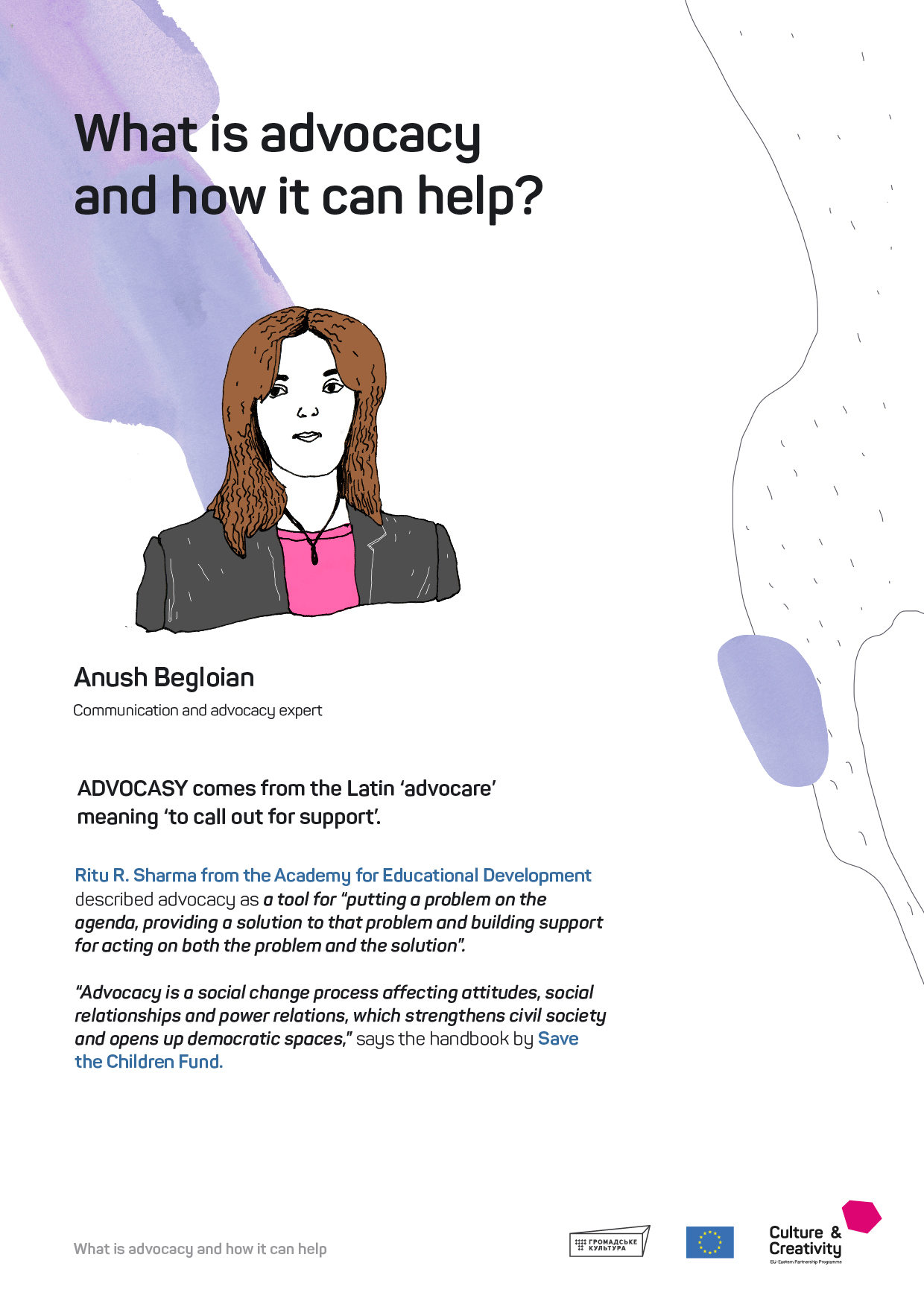- The Digital Communication Course
- Project Management in Culture Course
- The Culture & Creativity Course
-
The Communication Course
-
Lecture 1. The Basic Principles of Strategic Communication
-
Lecture 2. The Stages of Strategic Communication
-
Lecture 3. The Basic Principles of Strategic Communication
-
Lecture 4. The Basic Elements of Strategic Communication: Audience, Messages, Channels, Speakers and Time
-
Lecture 5. Media communications: tips for success
-
Additional resources
-
Test and certificate
-
- The Proposal Writing Course
- The Cultural Strategy Course
-
The Advocacy Сourse
-
Lecture 1. What is advocacy and how can it help?
-
Lecture 2. Issue analysis and identification
-
Lecture 3. Mapping the external environment
-
Lecture 4. Lobbying, influencing and getting your voice heard
-
Lecture 5. Advocacy campaign evaluation
-
Fact sheet on advocacy and lobbying
-
Advocacy Capacity Assessment
-
Case Study
-
Additional Reading Resources
-
Test and certificate
-
- The Finance and Project Budget Course
- The Donor Fundraising Strategy Course
- The Media Pitching Course
- The Strategic Planning Course
-
The Marketing Course
-
Lecture 1. What is ‘Marketing’?
-
Lecture 2. Marketing Strategy
-
Lecture 3. Listening to Customers
-
Lecture 4. Customer Benefits
-
Lecture 5. The 3Ms of Marketing
-
Fact Sheet. 20 Key Facts relating to Marketing
-
Checklist to ensure efficient marketing strategy
-
Case Study. The 3Ms of Marketing.
-
Test and certificate
-
- The Course on Creating Value in Creative Economy
- The Cultural Relations and Cultural Diplomacy Introduction Course
- The Creative Europe Course
-
The Crossovers & Fundraising Course
-
Lecture 1. Entrepreneurship and Innovation: Vectors for Successful Fundraising
-
Lecture 2. Business Models and External Financing for Creative Startups
-
Lecture 3. Crossovers: A Catalyst for Effective Business Planning
-
Links to online resources and resources for further reading
-
Fact sheet
-
Case studies
-
Test and certificate
-
-
An Introduction to Cultural Journalism Online Course
-
Lecture 1: What Is Cultural Journalism? (An Introduction to Cultural Journalism. Online course by Dr Maya Jaggi)
-
Lecture 2: What is Criticism? (An Introduction to Cultural Journalism. Online course by Dr Maya Jaggi)
-
Lecture 3: How to Interview Cultural Figures (An Introduction to Cultural Journalism. Online course by Dr Maya Jaggi)
-
Lecture 4: Conclusion - Building an Audience for Culture (An Introduction to Cultural Journalism. Online course by Dr Maya Jaggi)
-
FURTHER READING
-
Test and certificate
-
- Investor Pitching Course for Creative Businesses
That is why it is important to start with the original meaning of this word: the word “advocacy” comes from the Latin ‘advocare’ and literally means ‘to call out for support’. The origins of advocacy date back to ancient Rome and Greece when well-established orators would perform as advocates or wrote orations specifically for pleading someone’s cause. Personalities such as Cicero and Caesar were among the greatest Roman lawyers and advocates.
Ritu R. Sharma from the Academy for Educational Development describes advocacy as a tool for “putting a problem on the agenda, providing a solution to that problem and building support for acting on both the problem and the solution”. This definition expresses an important idea: In a digital and networked age, advocacy is not just about influencing public policy, but also and first of all about influencing public opinion.
As Dr. Sharma says, even if most of the time advocacy is defined as speaking on behalf of others, one of its aims must be raising the public’s consciousness about a particular issue.
The philosophy behind the social phenomena of advocacy is best explained in a handbook for planning advocacy by Save the Children Fund, UK. It says that “advocacy is a social change process affecting attitudes, social relationships and power relations, which strengthens civil society and opens up democratic spaces”. To fulfill its aspirations advocacy requires efforts coordination, strategic thinking, information, communication, outreach and mobilization.
Besides being extremely broadly defined, advocacy is surrounded by several persistent myths and misconceptions. Some of the most frequently heard are:
-
Advocacy is only for professional lobbyists: Obviously advocacy is a public activity while lobbying requires “behind-the-scene” activities in its very essence.
-
Advocacy is walking down the street with a bull horn or advocacy is rioting in a demonstration or protest rally: This myth mixes different concepts; rallies are activism, which are sometimes useful, but it’s not always effective advocacy.
-
Advocacy is the same as fundraising or donating to charity: Again, as we said above, advocacy is all about initiating social change, which definitely cannot achieved through just collecting funds. Social change is often achieved with little or almost no funds.
-
Advocacy consumes a lot of time; I’m too busy to get involved in advocacy: Advocacy doesn’t have to be complicated and time-consuming – a properly planned and organized campaign requires small actions from many people rather than big ones from a few.
-
Advocacy is all about “politics” (in a negative connotation): Advocacy can be political (i.e. lobbying for a specific piece of legislation), but is more often social and intellectual focused on speaking out on behalf of those without a voice.
In our first lesson we discussed the meaning of advocacy, its philosophy and purpose as well as dispelled some of the widespread myths surrounding it.
We now know that advocacy describes a method or approach used to change policies and practices, reform institutions, alter power relations, change attitudes and behaviors and give our project work a broader impact. In the next video and until the end of this course, we will go through the process of advocacy campaign design, exploring various stages of the advocacy process in-depth.

